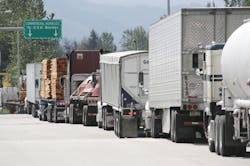For more on trucking's outlook:
What you'll learn about:
- The current political moves impacting trucking
- How tariffs may impact trucking in 2025
- What the trucking industry can expect going into 2025 overall
Trade wars and rumors of trade wars have muddied the economic outlook for 2025, making freight market and transportation equipment forecasts all the more challenging, as business analysts explained to Endeavor Business Media over the first few weeks of the new year.
U.S. President Donald Trump announced a flood of tariffs against Canada, Mexico, and China in early February, but quickly delayed implementation amid bipartisan concern over the tariffs’ potential economic impact. After promising retaliatory tariffs, Canada and Mexico reached separate deals with Trump to postpone their 25% tariffs for 30 days.
The tariffs are bad news for cross-border trucking volumes, equipment prices, and overall freight demand, according to early industry reactions. Businesses that import goods from Canada, Mexico, and China will pay a 10% to 25% levy on the import’s value to satisfy the tariff.
“As the trucking industry recovers from a years-long freight recession marked by low freight volumes, depressed rates, and rising operational costs, we have concern that tariffs could decrease freight volumes and increase costs for motor carriers at a time when the industry is just beginning to recover,” said Chris Spear, president and CEO of the American Trucking Associations. “A 25% tariff levied on Mexico could see the price of a new tractor increase by as much as $35,000. That is cost-prohibitive for many small carriers, and for larger fleets, it would add tens of millions of dollars in annual operating costs.”
Canada, Mexico, and China are the nation’s top three trade partners by value.
Impact on trucking, equipment
With the Mexican and Canadian tariffs, trucking is the most substantially affected transportation market. The conflict could stall growing cross-border trade with Mexico and Canada as nearshoring trends face headwinds.
“We firmly support policies that will secure our borders and protect legitimate trade, but we also recognize the unintended consequences that substantial tariffs could have over the long term, including higher consumer costs on the wide range of goods that cross our borders by truck, including food, automobiles, televisions, computers, furniture, and other key manufacturing inputs,” ATA’s spear added.
The Canadian Trucking Alliance also called for an end to the trade conflict.
“This has gotten out of hand,” said Stephen Laskowski, CTA president. “The reality is the tariffs are unreasonable and are out of proportion to the problem. The tariffs are like taking a sledgehammer to crack a nut.”
The Motor & Equipment Manufacturers Association likewise criticized the potential effects of the tariffs.
“Such tariffs would have severe consequences for the U.S. vehicle supplier industry, jeopardizing American jobs, increasing costs for consumers, and undermining the highly integrated North American supply chain that is critical to U.S. competitiveness,” the association said. “A 25% tariff would significantly increase the cost of essential vehicle components, with those added costs inevitably passed down to consumers.”
Indeed, tariffs and trade topped the talking points in a presentation by Ana Meuwissen, MEMA SVP of government affairs. She outlined the key issues at MEMA’s recent Heavy-Duty Aftermarket Dialogue conference, before the new tariffs were announced. (See the March magazine for complete event coverage.)
“This is the number one issue that we in the MEMA Government Affairs Office have been hearing about from member companies across the whole span of the industry,” Meuwissen said.
The latest trade agreement between North American countries also faces major revisions in mid-2026, and MEMA is hard at work in facilitating negotiations with industry stakeholders.
The United States-Mexico-Canada Agreement is a renegotiation of the North American Free Trade Agreement (NAFTA) under Trump’s first term. The trade deal has major influence on the U.S. economy broadly and the automotive and commercial vehicles industries specifically.
“This is the most stringent automotive and commercial vehicle agreement that we have on the books in the United States,” Meuwissen said. “We basically had a complete rewrite of our chapter of the agreement, with brand new rules and requirements being put in that impact the sector every day.”
The agreement entered force on July 2020 and has a 16-year timeline. Different vehicle classes covered by the agreement have multi-year phase-in periods. The phase-in period for commercial vehicles is seven years and concludes in 2027.
Another significant change for USMCA is a review mechanism, scheduled for July 2026, where the three countries will discuss how the agreement is working and make changes. However, the U.S. has never experienced a trade agreement review process like this, so the outcome of the review is uncertain.
“Honestly, we don’t know how the reviews can be managed,” Meuwissen said. “We’ve never done one like this before; there’s no prototype for this type of review.”
Some terms that the countries might renegotiate include restricting Chinese investment in Mexico, stricter regional value content requirements, and increased duty rates to compel compliance, she noted.
Regarding the Trump Administration’s talk of new tariffs, Wabash President and CEO Brent Yeagy noted that Wabash undertook steps following “the 2018 Trump tariff onslaught” that have “dramatically reduced” the company’s exposure, characterizing it “almost de minimis” at this stage.
“We have built quite a moat around the incoming supply tariff risk. We know our competitors are still substantially exposed to that tariff risk across many different dimensions, so we feel pretty good about that,” Yeagy said during the company’s Q4 earnings call. “From a manufacturing location standpoint, we have one facility that has some level of exposure to potential tariffs on Mexico. Our competitors have substantially more exposure than we do, and we have available capacity in our domestic operations to shift production as needed to minimize those tariff impacts if they were to occur.”
What to expect
Speaking with EBM in the days following the tariff announcements, Jennifer McNealy, director–CV market research and publications at ACT Research, suggested the rapidly evolving situation had the firm’s analysts scrambling to model the impacts on freight, trucks, and trailers.
“It’s a very fluid situation. We are working on scenarios, but to say what’s in those scenarios, and how many we’re going to end up having, I really don’t know,” she said. “It’s literally what we’re working on in-house right now.”
Not that the freight outlook for 2025 was overly promising to begin with.
“Those [carriers] that have managed to stick it out this far are probably pretty good at managing their costs,” Tim Denoyer, ACT Research VP and senior analyst, said. “And they’re going to need to stick it out for a while longer. The load activity is not really picking up very much yet.”
While there have been some positive signs around seasonal events, Denoyer suggested that demand remains relatively soft as many small fleets and owner-operators are more picky about their hauls.
“It’s going to take a little bit more economic growth and a reduction of equipment supply to turn the balance higher,” the ACT Research analyst said. “It’s not quite there yet. It’s going to be a little while.”
With prebuy activity already starting for fleets looking to get ahead of 2027’s more stringent emissions regulations, the next couple of years could be challenging for the industry with latent capacity and underutilized equipment affecting demand.
“That keeps the demand environment relatively soft—in part because private fleets are in-sourcing some freight,” Denoyer explained. “And in part because they’re also increasingly competing in the for-hire spot market.”
Denoyer did share some optimism but noted: “These next couple of years will be a challenge.”

